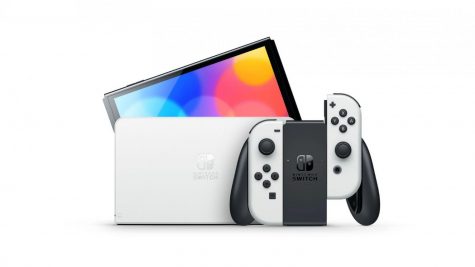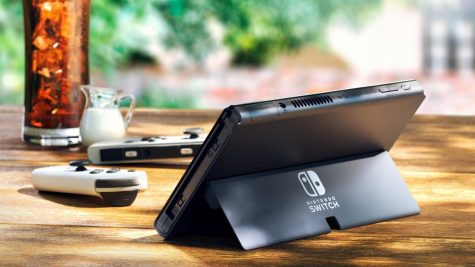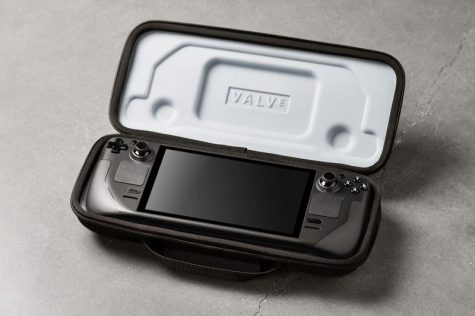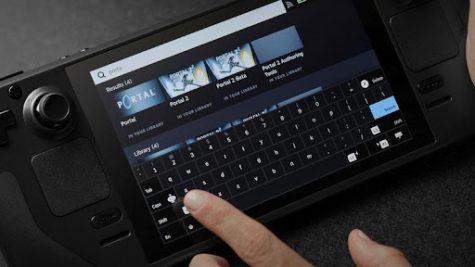The major Japanese gaming company, Nintendo, announced the newest edition of the Nintendo Switch console this month, Nintendo Switch (OLED model). Within a week afterward, another significant gaming company, Valve Corporation, revealed their new handheld device, Steam Deck. Today, the spark’s lit, and the battle is on for which handheld gaming device will reign supreme.
Nintendo has dominated the handheld gaming market since the 2017 release of the original Nintendo Switch model. Featuring a catalog of some of the most iconic titles in gaming history, Nintendo has rightfully earned its number one spot without much competition. But after Valve’s recent announcement of the Steam Deck, will Nintendo see a drop in sales for their newest model this time around?
Let’s break down the two new handheld gaming devices and see if they’re a worthwhile investment for anyone interested in what both companies have to offer.

Photo courtesy of Nintendo.
Nintendo has a catalog of more than 5,000 games featuring the most popular video game franchises of all time: Mario, Donkey Kong, Pokémon, The Legend of Zelda, Animal Crossing, and Super Smash Bros. Those titles have enough popularity to drive up a considerable loyal fanbase and establish incredible sales numbers for Nintendo throughout the years.
Only one problem arises: if a customer of the newest Switch model isn’t familiar with Nintendo’s impressive history, there isn’t an extensive list of third-party developed games on the platform in substitution. Typically, new games release on PC, Xbox, and PlayStation before making their way to the Nintendo Switch. But the gaming company seems to have enhanced the flow of non-Nintendo games in recent years and is making the same day-and-date releases for a few AAA titles.
Not much has changed from previous Nintendo Switch models besides a few components: the seven-inch OLED screen, a built-in wired LAN port, an adjustable stand for tabletop mode, 64 GB internal storage, and enhanced audio.
The arrival of the OLED screen will present games with deeper blacks and vivid colors, but it doesn’t make a difference when docking the Switch. The 64 GB memory upgrade, enhanced audio, and built-in wired LAN port for stable internet connection are aspects that should already exist within the console. Nonetheless, the wide, adjustable stand is a pleasant add-on because the tabletop mode promotes shoulder-to-shoulder co-op gameplay that’s currently missing.

Photo courtesy of Nintendo.
In general, any Nintendo Switch model is ideal for people who want to game with friends and family. Up to four people can play together when the console is docked and connected to the television. Although, the Switch in handheld mode is for individual use and the Joy-Con controllers remain attached to the console.
Here are a few of the technical specifications for the Nintendo Switch (OLED model). For a complete list of the specs, visit the official website here.
- Display: Multi-touch capacitive touch screen / 7.0 inch OLED screen / 1280×720
- CPU / GPU: NVIDIA Custom Tegra processor
- Storage: 64 GB (Users can expand storage space using microSDHC or microSDXC cards up to 2TB) sold separately*
- Wireless: Wi-Fi (IEEE 802.11 a/b/g/n/ac compliant) / Bluetooth 4.1
- Video output: Up to 1080p via HDMI in TV mode / Up to 720p via built-in screen in Tabletop mode and Handheld modes
- Audio output: Compatible with 5.1ch Linear PCM output / Output via HDMI connector in TV mode
- USB connector: USB Type-C / Used for charging or for connecting to the Nintendo Switch dock
- Headphone / mic jack: 3.5mm 4-pole stereo (CTIA standard)
- microSD card slot: Compatible with microSD, microSDHC, and microSDXC memory cards.
- Internal battery: Lithium-ion battery / 4310mAh
- Battery life: Approximately 4.5 – 9 hours
- Charging time: Approximately 3 hours
The white set and the neon blue/red sets are currently out of stock on all retail websites, but keep checking back to Nintendo’s official website for restocking information in the coming months.
Nintendo Switch (OLED model) will release Oct. 8, 2021, at $349.99.

Photo courtesy of Valve.
First, it’s best to explain what Steam is for those unaware of the PC gaming world. Steam is an online service that provides access to an endless amount of video games available to purchase. Steam also has a healthy community page and an interactive friends list to stay connected; it’s been a significant contributor to the way people play video games on the computer since its development and release by Valve in 2003.
The Steam Deck is a dream for gamers who own a PC and have already established their gaming library on Steam. Valve is calling the Deck an all-in-one portable PC gaming device, and they aren’t kidding. The player’s library of games and friends list will instantly be available after powering on the device and logging in to Steam for the first time. For those without a computer, the Steam Deck is a great way to play PC games without the intimidation of managing an expensive rig.
Valve is introducing a new version of the Steam operating system for the handheld device. This version of the SteamOS is designed with the Deck in mind and will optimize games for the best gaming experience on a handheld device. In addition, given the Steam Deck is a portable PC and has separate technology inside than a phone or tablet, users will even have the freedom to download Windows. Meaning the Steam Deck will have access to Xbox’s game pass and online service, essentially making it another device to download Xbox games without having to stream from the cloud.
The button, trigger, and thumbstick layout on the front and back of the Steam Deck is a standard configuration which makes it a familiar layout for a wide range of gamers. Nonetheless, the functionality of the trackpads is similar to using a computer mouse and allows the player to enjoy games not designed to be on a handheld device. The Steam Deck does not have detachable controllers, but it does have a docking station allowing the option to play on a television or monitor. Additionally, the Steam Deck accepts the use of wired and wireless (Bluetooth) peripherals such as a keyboard, mouse, and headphones while docked.

Photo courtesy of Valve.
Here are a few of the technical specifications for the Steam Deck. For a complete list of the specs, visit the official website here.
- Display: seven-inch 1280×800 (16:10), 60Hz LCD touchscreen
- CPU / GPU: AMD Zen 2 4c/8t, 2.4 – 3.5GHz / 8 RDNA 2 CUs, 1.0-1.6GHz
- Storage: 64GB / 256GB / 512GB. Expandable with MicroSD cards
- Wireless: Wi-Fi and Bluetooth
- Wired: USB-C with DisplayPort 1.4 Alt-mode support; up to 8K @60Hz or 4K @120Hz, USB 3.2 Gen 2
- Battery life: Approximately 2 – 8 hours
The Steam Deck is currently available for reservation on the official website. Valve has three versions of the device available; the products begin to ship out during Spring of 2022. Here’s the breakdown of each Steam Deck you can reserve now for a five-dollar deposit.
$399 – 64GB
- 64GB eMMc internal storage
- Carrying case
$529 – 256GB
- 256GB NVMe SSD internal storage
- Faster storage
- Carrying case
- Exclusive Steam Community profile bundle
$649 – 512GB
- 512GB NVMe SSD internal storage
- Fastest storage
- Premium anti-glare etched glass
- Exclusive carrying case
- Exclusive Steam Community profile bundle
- Exclusive virtual keyboard theme
Whichever Steam Deck seems ideal, keep in mind that storage isn’t necessarily an issue since the device allows microSD cards and has an internal solid-state drive. However, Valve recently said adding internal storage is possible but does not recommend the action. With that said, the cheaper option seems like the right choice for those experienced with configuring PC components. For inexperienced customers, the best option is to purchase the second unit that already has a solid-state drive within. The reasoning is because the SSD has a significant performance advantage over eMMC internal storage when managing large files, and video games aren’t getting any smaller.
Overall, the Steam Deck has better technology than the Nintendo Switch (OLED model). Also, the Steam Deck is a portable PC which means it has access to Windows 10, allowing for more gaming possibilities on the go. In contrast, the Nintendo Switch (OLED model) is a device to play with family and friends. Furthermore, it’s worth considering the Switch (OLED model) because Nintendo is home to many gaming franchises customers won’t find anywhere else.
Regardless of whichever device you choose, it’s an exciting time to be a fan of handheld gaming. If sales skyrocket for the Steam Deck and Nintendo stay consistent, other technology companies may perhaps take advantage of the opportunity to innovate and create more handheld gaming devices in the following years to come.
________
For more information or news tips, or if you see an error in this story or have any compliments or concerns, contact editor@unfspinnaker.com.
















